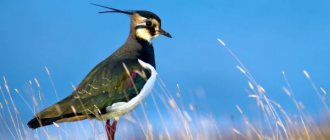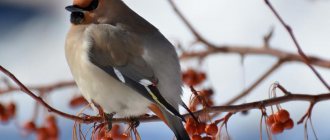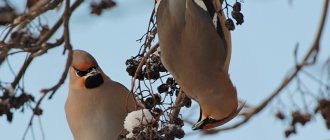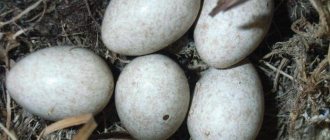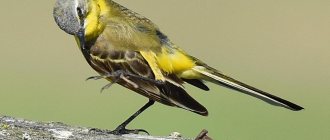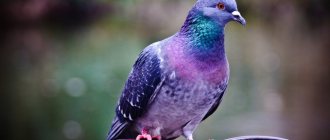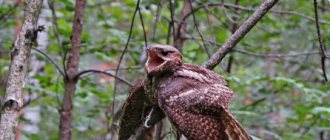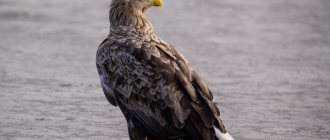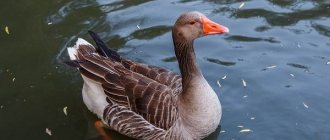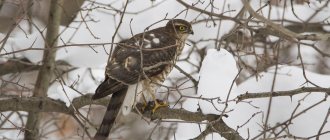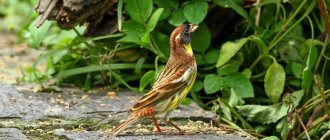- April 17, 2019
- Birds
- Natalia Egorenkova
Nature has its own view of how birds should look. Some are completely inconspicuous, others seem to be painted with the brush of a mad artist. And some were lucky enough to become the owners of a special decoration - a bunch of feathers on their heads.
We will tell you about the most famous birds with a crest that live in Russia and other countries of the world, we will describe their habitats and interesting features.
Waxwings
People call these birds Khokhliki, which very accurately conveys the main feature of their appearance. The waxwing is a small bird, about 23 cm in length and weighing up to 70 g.
The waxwing family and genus Waxwings includes only 3 species:
- The common waxwing is an inhabitant of the taiga zone.
- The Amur waxwing is a common bird in the Amur and Primorye regions. It is found in wintering grounds in China, Korea and Japan.
- The American waxwing is a typical inhabitant of the forests of Canada and the northern states of the United States.
All waxwings are birds with a crest. They are famous for their singing talent and insatiable eating of berries. Overripe fruits cause fermentation in the stomachs of birds, and the released alkaloids cause disorientation. You've probably heard stories about "drunk waxwings", which often end in tragedy. Birds hit the windows, bump into all surrounding objects and fall from the sky in flocks. Therefore, in the old days, their appearance and strange behavior were considered a bad omen.
A bird with a crest on its head, waxwing - description and features
A drunkard among the birds. The waxwing earned such fame . The bird feeds on berries. In cold weather, fermentation processes begin in them. Drinking this “berry wine” waxwings get drunk.
Intoxicated, the birds fall into snowdrifts, crash into houses, windows, and fly into wires. In general, the taste preferences of waxwings increase the mortality of birds. They are as bright and extraordinary as their lives.
Hoopoe
This is one of the most recognizable birds in the avifauna of the Old World. And all thanks to the long down-curved beak, luxurious orange-colored crest with black tips and contrasting black and white plumage of the wings and tail.
The popular names for hoopoe are dummy and tattoo. Probably due to the birds' habit of hiding, lying flat on the ground with their beak sticking up.
The hoopoe is a small bird. Its height usually does not exceed 30 cm, and its wingspan is about half a meter.
Hoopoes live in steppes, savannas and near arable fields throughout almost the entire territory of Eurasia and Africa, south of the Sahara Desert.
Lifestyle
In their habits, hoopoes resemble starlings, which are much more familiar to us. And if the bird feels a threat from which it cannot escape, then it presses itself to the ground, swells in size and raises its beak.
Habitats
Hoopoes are common in the eastern and southern regions of Asia, Europe and Africa. But sometimes they are found in Scandinavia, the Alps and the Baltic states. In Russia, hoopoes can be found in the wild near the Gulf of Finland and in most other areas of the European part.
The hoopoe prefers open areas without grassy thickets, but with isolated tall trees. This is a bird of the steppe and savannah, as well as of pastures and vineyards. Occasionally, hoopoes settle in cities near landfills.
Photo: komotoz.ru
Diet
The hoopoe mainly feeds on insects and other invertebrates. These are beetles, grasshoppers, butterflies, larvae, ants and termites, spiders, mollusks, wood lice, small lizards and frogs. The hoopoe masterfully hunts in the grass and finds its prey in the ground, wood and even garbage heaps.
Photo: wikids.ru
Wintering
The tendency of a hoopoe to migrate completely depends on the region of its residence. Most often they go to winter in Africa, the Mediterranean and the southern regions of Asia. The migration season is very spread out: for some species from July to February, and for others from October to May.
Photo: funart.pro
Captivity
The hoopoe gets used to a person well and will not fly away from him. The easiest way to tame teenage chicks, which are not yet accustomed to independent life, but are already fully fledged.
Photo: club.foto.ru
Waxwing (60 photos): description of the bird, where it lives and what it eats
Lapwing
Another name for this bird is pigtail. The lapwing has a dense, round body on thin legs and a small head with a tuft of long feathers. The height of an adult bird is about 30 cm.
The lapwing is a bird with a characteristic black and white plumage and blunt wings, which distinguishes it from other related species. Despite this feature, lapwings are excellent flyers and during the mating season, males stage real aerial shows in front of females.
The range of lapwings is extremely large and extends from the Atlantic coast to the Pacific Ocean. The favorite habitats of these birds are damp meadows, which is why they are sometimes called meadows, as well as wetlands in forests.
Lapwings are very loud birds. In the old days they were not loved precisely because of their drawn-out, mournful cry, which was considered a harbinger of trouble. In the 20th century, the bird's reputation was restored, and everyone born in the USSR probably knows the cheerful children's song "Lapwing by the road."
Reproduction
The hoopoe is a monogamous bird. Reaches sexual maturity at the age of one year.
Mating season
Arrives at nesting sites in March or April. Males immediately occupy the nesting territory and behave extremely actively: they scream loudly and make repeated dull “whoop-whoop” sounds to call the females. Hoopoes scream most often and loudly during this period in the mornings and evenings. During courtship, the male and female fly after each other and choose a place for the nest. The couple usually uses the same territory for several years in a row.
Nest
Hoopoes build nests in secluded places, for example, in tree hollows, rocky crevices, recesses on cliff slopes, and occasionally in the walls of stone or clay buildings. If the birds do not find shelter, they lay eggs directly on the ground in the dried remains of the animal. Hoopoes do not line the nest from the inside, or they bring a little grass, feathers, or pieces of cow dung. In hollows, rotten wood dust serves as litter.
Hoopoes never remove droppings from the nest, and during nesting they secrete an oily liquid with a strong unpleasant odor. This protects the birds from land-based predators, but people call the hoopoe "unclean."
Laying eggs
There are from 5 to 9 eggs in a clutch, on average 4-7. The eggs are oblong, grayish-white or dark brown. The female lays one egg per day, but begins incubation from the first. The male does not participate in incubating the eggs; he obtains food for the female.
Chicks
The incubation period lasts 25-32 days. The chicks are born blind, covered in reddish down, which changes to pinkish-white and thick. Both partners feed the offspring with insects and worms. At the age of 20-27, the chicks leave the nest.
Jay
Along with waxwings, the jay is one of the most famous forest birds with a crest. Adults grow up to 40 cm including the tail and weigh about 200 g. Their wide crest can stick up or look sleek.
The name of the bird comes from the Old Russian word “soy”, which meant “to shine”. Indeed, the jay's plumage is quite variegated: the body is brick-colored, the tail and wings are black, and the shoulders are turquoise.
These birds can be found in the forests of Europe, East Asia and northern Africa. Jays are famous for their amazing ability to imitate onomatopoeia. They easily imitate squeaks, knocks and even the human voice.
Voice
The hoopoe's voice is dull, guttural, and consists of three to five syllable calls “up-up-up” or “ud-ud-ud”, which are repeated several times in a row. The name of the bird is onomatopoeic to this song. A surprised or frightened bird emits a piercing cry “chii-eeer”, similar to the voice of a turtle dove. During the mating season or while courting chicks, hoopoes make dull, rolling sounds.
Only the Madagascar hoopoe differs from all subspecies in its voice; its song resembles a booming purr.
Tufted tit
The name of this bird speaks for itself. Thanks to its striking black and white conical crest, the tufted tit is often called a grenadier or grenadier.
The height of representatives of the species is from 11 to 14 cm, and they weigh only 14 g. The color of the plumage of the tufted tit is brownish-gray in the upper part and yellowish-white below.
This is an exclusively European bird, living in coniferous forests in the north of its range, and in deciduous forests closer to the south.
Also worth noting is the second species of the tufted tit genus - the gray-crested tit. This inconspicuous gray bird with a tuft lives in the tropical rainforests of South and East Asia.
Description of waxwings
The waxwing is popularly considered a “beautiful bird” that cannot sing, but only chirps and whistles, emitting characteristic trills - “sviririri...”. Flocks of waxwings, elegant crested birds, always attract the attention of people in cities and countryside. These short-legged birds are slightly smaller than a starling. The tops of their heads are decorated with large pink tufts. The body (about 15 - 18 cm long) is covered with pinkish-gray plumage. It is brownish-gray with red plumage, and from a distance it looks pinkish-gray. Stripes of yellow and white coloring are clearly visible on the black wings. The tail, throat and stripe near the eyes are black. The tail is edged with a yellow stripe, the wings are decorated with a narrow white stripe. Up close you can see the red tips of the flight feathers.
Oatmeal-remez
The genus of true buntings includes about 40 species of birds. But only the remez bunting has a distinctive feature - a well-defined crest on the head. This is a small bird, up to 15 cm long and weighing about 20 g.
During the nesting period, the remez bunting is found in damp coniferous forests of northern latitudes: from Scandinavia to the Bering Strait. These birds winter in the eastern regions of China and Japan.
Great grebe
This waterfowl is very loved by illustrators of children's books, and all because of the original tufts of feathers on its head, forming 2 fluffy crests. It is interesting that birds only have this decoration in their spring plumage. The same goes for the red “collar” around the neck.
In the literature, the great grebe is more often found under the name grebe. It is slightly smaller in size than a duck. She has a thin flexible neck, a long beak and leathery membranes on her feet - everything necessary for an aquatic lifestyle.
Great grebes live in stagnant bodies of water throughout Eurasia, with the exception of the extreme northern regions, and are found in Australia and New Zealand, as well as in some areas of Africa.
Golden Pheasant (Chrysolophus pictus)
photo Cuong Cao flickr.com
Native to Western and Central China, golden pheasants are one of the most beautiful birds in the world. The male is brighter in color than the female. The females are a dull brown color, while the male is a mixture of several bright colors.
Despite the multi-colored plumage, the fantastic crest can be called the most remarkable feature of the males of these pheasants. These long golden yellow crest feathers reach to the end of the neck.
When feathered on the body, the golden pheasant has red underparts, a bright yellow wattle, green upper back, goldfish and a long brown tail. Interestingly, the male golden pheasant's long tail accounts for two-thirds of its total length.
Red cardinal
A very beautiful bird with a crest on its head, also known as the Virginia cardinal. Seven US states, including Virginia, consider the feathered beauty their official symbol.
It is easy to identify the male by its bright crimson plumage and black mask. Female red cardinals are gray-brown, with a faded mask and slight splashes of red on the chest, wings and crest. The birds' height is about 20 cm with an average body weight of 30 g.
Red cardinals are extremely unpretentious in their choice of habitats and feel great in various forests and city parks. Sometimes they are spotted even in Washington.
In addition to the eastern United States, red cardinals live in Mexico and some areas of Canada. Since the 18th century, birds were brought to Bermuda and Hawaii, where they successfully took root.
Anatomical characteristics of waxwings
The body length of these amazing feathered creatures is about 19-23 cm. Their body weight varies from 60 to 68 cm. The tail is short. The wingspan reaches 36 cm. The legs of waxwings are quite short. This allows birds to hide them from the cold in warm plumage. Fingers are very tenacious. The body is very dense and knitted. The head is supported by a large neck. The bird's plumage fits tightly to the body. This structure allows waxwings to survive even in extreme cold. Among other things, they are excellent flyers, capable of performing the most incredible maneuvers in the air.
The description of most species of these birds is approximately the same, with the exception of the black variety. The common waxwing looks colorful. The birds have a bright red-brown crest on their heads. From the temple area along the eye and up to the bridge of the nose stretches a kind of black mask, which is only slightly bordered on the sides by a white stripe. The bird's beak is short and black. The iris of the eye is dark in color, so from the outside it may seem that the bird is wearing a mask. The remaining part of the head, throat and back are covered with bright red-brown plumage. The top of the back is gray-brown, the tail part is gray. The bird's belly is light beige. The plumage in the rump area is white.
This feathered creature got its name due to the characteristic whistle it makes.
The flight feathers on the wings are black and gray in color, but they have several bright red spots. Some species of waxwings have a black collar under the breast, and the tip of the tail is yellow with black stripes. There are also bright spots on the wings. The plumage of such individuals is grayer. Black waxwings differ significantly from their relatives. Only females of this species have light gray plumage. Males are distinguished by their coal-black color. The crest of birds always stands straight. The overall gloomy appearance is complemented by bright red eyes.
Himalayan monal
This is one of the most beautiful pheasants with an elegant tuft of feathers on its head. But unlike most other birds with a crest, only males have this decoration. Their plumage shimmers in the sun with copper, turquoise, green, purple, scarlet and other colors.
Females don't look as impressive. They are dark or light brown with cross shading. Males grow up to 70 cm in length including the tail, females are somewhat smaller.
The Himalayan manal prefers to live in the mountainous regions of the Himalayas, at an altitude of up to 5 km above sea level.
Guinea turaco (Tauraco persa)
photo by Marilyn M. Bergman flickr.com
The Guinea turaco is a medium-sized bird with unusual plumage. This beautiful bird lives in savannas and forest areas of Africa. The turaco's plumage is green from head to chest. The back and tail are dark purple in color. But, the 2-inch long green crest is the most striking feature of the Guinea Turaco. Turakos display a full length of their feathers when warned.
Crowned pigeons
Birds of extraordinary beauty, whose heads are crowned not just with crests, but with real crowns.
The genus of crowned pigeons includes 3 species, and all of them live only on the island of Papua New Guinea:
- crowned pigeon;
- chestnut-breasted crowned pigeon;
- fan crowned pigeon.
Interestingly, males and females look exactly the same. However, they differ from pigeons in the usual sense not only in their crest and unusual plumage color, but also in size. The height of crowned pigeons reaches 80 cm, and they weigh about 2.5 kg.
The local population exterminated these birds for tasty meat, which led to a sharp decline in the population. Today, crowned pigeons are a vulnerable species and are protected by the state.
Secretary Bird
These birds of prey with a crest of black feathers are depicted on the coats of arms of South Africa and Sudan. Their unusual name is explained by the clear resemblance of the birds to court secretaries, who in the old days decorated their wigs with goose feathers.
The size of adult males and females ranges from 1.25 to 1.55 m. Secretaries weigh about 4 kg. They live in African savannas, where they hunt mainly snakes, but will not refuse to eat a lizard, frog, small animal or bird. In Africa, secretaries are highly respected and appreciated for the fact that they regularly carry out their noble mission of exterminating snakes.
THRUSH OBSERVATIONS
You don’t have to travel far to see a blackbird; you can even see it in the city center. Busy searching for food, it quickly and deftly jumps along the ground with its tail slightly raised and wings lowered - thanks to this behavior it can be easily distinguished from a rook. After all, the same black one is distinguished by the fact that it calmly walks on the ground. In the forest, blackbirds lead a rather solitary life, so it is much more difficult to find them here. And in the forest you can hear the song of this bird. It resembles the song of a songbird, but the blackbird's song is a little slower and sadder.
- Blackbirds living in cities sometimes even nest in flower pots, on window cornices and balconies.
- There is a known case when a pair of blackbirds had four clutches over the course of a year and raised 17 chicks.
- The female blackbird resembles a song thrush, whose throat and chest are also spotted. Sometimes male blackbirds mate with female songbirds and they produce offspring.
- During autumn migrations south, strong winds can carry flocks of blackbirds to the other side of the Atlantic Ocean.
